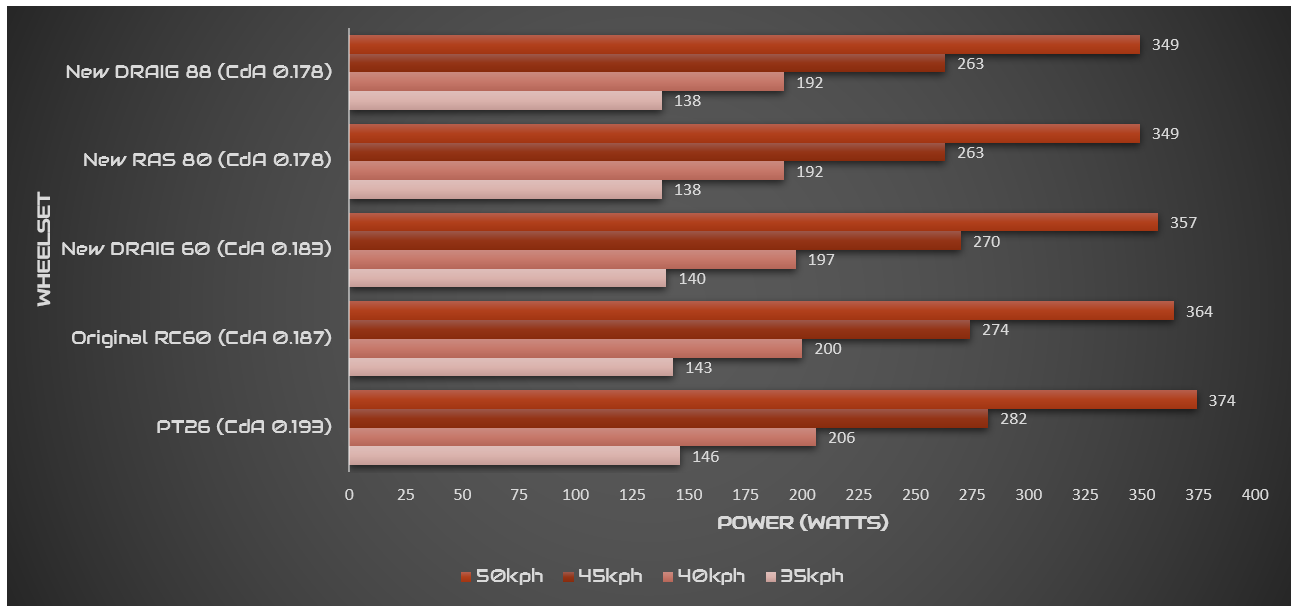Aerodynamic Wheels
Understand the performance of the new DRAIG & RAS Aerodynamic Wheels
Since CES was launched back in 2016, we’ve always been asked the question regarding the performance of aerodynamic wheels and realistically what the impact of changing wheels would have on an athletes performance. With the development of our new wheelsets, we have been able to carry out ‘real world’ aerodynamic wheels testing with the support of Andy Sexton from BikeScience and professional triathlete Tara Grosvenor, where we have compared our traditional 60mm rim versus our PT26 aluminium rims, but also against some newer, wider, rim designs. The new rim profiles have also been built using a more aerodynamic, elliptical shaped spoke.

Venue: Maindy Outdoor Velodrome, Cardiff
Test Method: Two runs were performed with each wheelset (other than training wheels which time only allowed one run).
All run data was captured using the 2021 version AeroLab onboard data recording device. Wheel speed data was recorded with a magnetic rear wheel sensor and the tyre circumference measured prior to testing to ensure accurate speed results. Data was post processed and checked for validity by AeroLab Tech. For the aero data presented below, the best run for each wheelset has been displayed as rider positioning is considered to be the main cause for any run with significantly poorer performance
Weather & Conditions: Testing Temperatures averaged 5°C with air pressure ranging from 1031 to 1034 mbar. The track surface at Maindy Velodrome was generally very good. Wind speeds were very low, with speeds below 8mph for the duration of the test with no noticeable gusts. The high banks of the velodrome also offered significant shelter from wind.
Test Pilot: Pro triathlete Tara Grosvenor. Tara has undergone aero testing with Bike Science on previous occasions and her CdA values during this test were within the range expected in comparison to results from previous tests.
Clothing: Tara was wearing winter cycling clothing as opposed to race kit, including North Wave winter boots.
Helmet: Kask Bambino
Bike: 2021 model Argon E119 disc
Tyres & Pressures: All tests were done using Hutchinson Fusion 5 (700×25) set up tubeless. Tyre pressures were 80PSI rear and 70PSI front.

Results
All the carbon wheelsets offer a significant saving in power when compared to the alloy PT26 wheelsets, which will hopefully offer an answer to the first question some may have with regards to the upgrade from stock wheels provided with their bike. Upgrading from the PT26 to the new DRAIG 60 wheels would offer in the region of 6 watts when cruising at 35kph.
Some noticeable results from the test data is the saving in watts between the RC60 and DRAIG 60, but also then the further upgrade to the RAS80. An 8 watt saving is quite considerable when getting up towards a speed of 40kph.
There’s a noticeable similarity in results between the RAS 80 and the new design 88 rim, which begs the question, do we always need to go deeper to go faster? This would suggest no, plus a shallower rim will also offer greater handling ability.
Notes
- CdA is a measure of the overall drag of both rider, bike and equipment. A low CdA number will result in lower power being required to maintain any given speed.
- The approximate Wattage needed to maintain constant speed on a straight level road in wind conditions as per those experienced during the test session (ie. a pretty much still day).
- Different wind conditions would present different results.
- It is important to note that the Wattages shown above are approximate values only and have been calculated using a rolling resistance constant Crr of 0.005 and an air density value of 1.22601kg/m3.
- It is worth taking into consideration that the “Training Wheel” configuration included changing both front and rear wheels. All other configurations include the CES Disc rear wheel and changed just the front wheel
The new DRAIG and RAS ranges COMING SOON!

